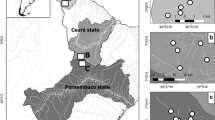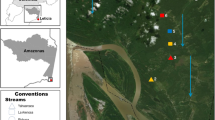Abstract
Habitat segregation is considered the most prevalent resource-partitioning mechanism for stream fishes and the species morphology can be a strong predictor of their spatial distribution. However, most studies addressing morphology-habitat relationships have defined the space in physiognomically homogeneous units (i.e., mesohabitat), probably not detecting segregation among several closely related species. Here we investigated the ecomorphology and the use of habitat in a fine spatial scale (i.e., microhabitat) by two closely phylogenetically related grazer fishes (the loricariids Parotocinclus maculicauda and Hisonotus notatus), syntopic in an Atlantic Forest stream. We conducted standardized underwater observations in two 50 m long stream sections differing in canopy condition, totaling 273 individual microhabitat records. We clearly detected microhabitat segregation between the species. In both sample sites, H. notatus remained near the stream banks and closer to shelters, while P. maculicauda predominantly occurred in more hydrodynamic microhabitats, facing higher focal current velocities and water turbulence. Differences in focal elevation and water depth (i.e., vertical segregation) were exclusively detected in the deforested site. The spatial segregation was congruent with slight interspecific morphological differences, being in accordance with hypotheses about form-function relationships previously reported for fishes. Given that the diel activity and diet of these grazer species were strongly overlapping, we believe that the observed microhabitat segregation favors resource partitioning between P. maculicauda and H. notatus, facilitating their coexistence in high abundances in the studied system. This study illustrates how the assessment of fine-tuned ecological processes can provide subsidy to management strategies aiming the conservation of tropical stream biodiversity.






Similar content being viewed by others
References
Allan JD, Erickson DL, Fay F (1997) The influence of catchment land use on stream integrity across multiple spatial scales. Freshw Biol 37:149–161
Aranha JMR (1993) Método para análise quantitativa de algas e outros itens microscópicos de alimentação de peixes. Acta Biol Par 22:71–76
Bojsen BH, Barriga R (2002) Effects of deforestation on fish community structure in Ecuadorian Amazon streams. Freshw Biol 47:2246–2260
Brito MFG (2007) Atividade reprodutiva dos peixes do rio Macaé (RJ) em função do gradiente longitudinal. Dissertation, Universidade Federal do Rio de Janeiro
Brooks DR, McLennan DA (1993) Historical ecology: examining phylogenetic components of community evolution. In: Ricklefs RE, Schluter D (eds) Species diversity in ecological communities: historical and geographical perspectives. University of Chicago Press, Chicago, pp 267–280
Buck S, Sazima I (1995) An assemblage of mailed catfishes (Loricariidae) in southeastern Brazil: distribution activity and feeding. Ichthyol Explor Freshw 6:325–332
Burcham J (1988) Fish communities and environmental characteristics of two lowland streams in Costa Rica. Rev Biol Trop 36:273–285
Carvalho LN, Zuanon J, Sazima I (2009) Natural History of Amazon Fishes. In: Del Claro K, Oliveira PS, Rico-Gray V, Ramirez A, Barbosa AAA, Bonet A (eds) Tropical biology and conservation management: case studies. Eolss Publishers Co. Ltd., Oxford, pp 113–144
Casatti L, Castro RMC (2006) Testing the ecomorphological hypothesis in a headwater riffles fish assemblage of the rio São Francisco, southeastern Brazil. Neotropical Ichthyol 4:203–214
Casatti L, Rocha FC, Pereira DC (2005) Habitat use by two species of Hypostomus (Pisces, Loricariidae) in southeastern brazilian streams. Biota Neotrop 5:1–9
Douglas ME, Matthews WJ (1992) Does morphology predicts ecology? Hypothesis testing within a freshwater fish assemblage. Oikos 65:213–224
Erös T, Botta-Dukát Z, Grossman GD (2003) Assemblage structure and habitat use of fishes in a Central European submontane stream: a patch-based approach. Ecol Freshw Fish 12:141–150
Garavello JC, Britski HA (2003) Parotocinclus planicauda, a new species of the subfamily Hypoptopomatinae from southeastern Brazil (Ostariophysi: Loricariidae). Braz J Biol 63(2):253–260
Gatz AJ (1979a) Community organization in fishes as indicated by morphological features. Ecology 60:711–718
Gatz AJ (1979b) Ecological morphology of freshwater stream fishes. Tulane Stud Zool Bot 21:91–124
Gauger MFW, Buckup PA (2005) Two new species of Hypoptopomatinae from the rio Paraíba do Sul basin, with comments on the monophyly of Paratocinclus and the Otothyrini (Siluriformes: Loricariidae). Neotrop Ichthyol 3:509–518
Granado-Lorencio C, Garcia-Novo F (1981) Cambios ictiológicos durante las primeiras etapas de la Sucesión en embalse de Arrocampo (Cuenca del rio Tajo, Cáceres). Bol Inst Esp Oceanogr 6:224–243
Gray ES, Stauffer JR (1999) Comparative microhabitat use of ecologically similar benthic fishes. Environ Biol Fish 56:443–453
Grossman GD, Freeman MC (1987) Microhabitat use in a stream fish assemblage. J Zool 212:151–176
Grossman GD, Sostoa A, Freeman MC, Lobón-Cerviá J (1987) Microhabitat use in a Mediterranean riverine fish assemblage: fishes of the lower Matarraña. Oecologia 73:490–500
Grossman GD, Ratjczak RE, Crawford M, Freeman MC (1998) Assemblage organization in stream fishes: effects of environmental variation and interspecific interactions. Ecol Monogr 68:396–420
Hardin G (1960) Competitive exclusion principle. Science 131:1292–1297
Herder F, Freyhof J (2006) Resource partitioning in a tropical stream fish assemblage. J Fish Biol 69:571–589
Hutchinson GE (1957) Concluding remarks. Cold Springs Harb Symp Quant Biol 22:415–427
Iglesias-Rios R (2004) A teoria do nicho ecológico: benefícios e malefícios. In: Coelho AS, Loyola RD, Souza MBG (eds) Ecologia Teórica: desafios para o aperfeiçoamento da Ecologia no Brasil. O Lutador, Belo Horizonte, pp 27–41
Jackson DA, Peres-Neto PR, Olden JD (2001) What controls who is where in freshwater fish communities: the roles of biotic, abiotic, and spatial factors. Can J Fish Aquat Sci 58:157–170
Kano Y, Miyazaki Y, Tomiyama Y, Mitsuyuki C, Nishida S, Rashid ZA (2013) Linking mesohabitat selection and ecological traits of a fish assemblage in a small tropical stream (Tinggi River, Pahang Basin) of the Malay Peninsula. Zool Sci 30:178–184
Keenleyside MHA (1979) Diversity and adaptation in fish behaviour. Springer, Berlin
Krebs CJ (1999) Ecological Methodology, 2nd edn. Benjamin Cummings, California
Langerhans RB, Layman CA, Langerhans AK, Dewitt TJ (2003) Habitat-associated morphological divergence in two Neotropical fish species. Biol J Linn Soc 80:689–698
Leal CG, Junqueira NT, Pompeu PS (2010) Morphology and habitat use by fishes of the Rio das Velhas basin in southeastern Brazil. Environ Biol Fish 90:143–157
Leitão RP, Caramaschi EP, Zuanon J (2007) Following food clouds: feeding association between a minute loricariid and a characidiin species in an Atlantic Forest stream, Southeastern Brazil. Neotrop Ichthyol 5:307–310
MacArthur R, Levins R (1967) Limiting similarity convergence and divergence of coexisting species. Am Nat 101:377–387
Matthews WJ (1985) Critical current speeds and microhabitats of the benthic fishes Percina roanoka and Etheostoma flabellare. Environ Biol Fish 12:303–308
Mitchell SC (2005) How useful is the concept of habitat? A critique. Oikos 110(3):634–638
Peres-Neto PR (2004) Patterns in the co-occurrence of fish species in streams: the role of site suitability, morphology and phylogeny versus species interactions. Oecologia 140:352–360
Power ME (1984a) Depth distributions of armored catfish: predator-induced resource avoidance? Ecology 65:523–528
Power ME (1984b) Habitat quality and the distribution of algae-grazing catfish in a Panamanian stream. J Anim Ecol 53:357–374
R Core Team (2013) R: a language and environment for statistical computing. R Foundation for Statistical Computing, Vienna, Austria, URL http://www.R-project.org/
Reist JD (1985) An empirical evaluation of several univariate methods that adjust for size variation in morphometric data. Can J Zool 230:513–528
Rezende CF, Moraes M, Manna LR, Leitão RP, Caramaschi EP, Mazzoni R (2010) Mesohabitat indicator species in a coastal stream of the Atlantic rainforest, Rio de Janeiro-Brazil. Rev Biol Trop 58:1479–1487
Rincón PA (1999) Microhabitat use by fishes in small streams: methods and perspectives. Oecologia Aust 6:23–90
Romero RM, Casatti L (2012) Identification of key microhabitats for fish assemblages in tropical Brazilian savanna streams. Int Rev Hydrobiol 97:526–541
Rosenfeld J (2003) Assessing the habitat requirements of stream fishes: an overview and evaluation of different approaches. Trans Am Fish Soc 132:953–968
Roth NE, Allan JD, Erickson DE (1996) Landscape influences on stream biotic integrity assessed at multiple spatial scales. Landsc Ecol 11:141–156
Sabino J, Zuanon J (1998) A stream fish assemblage in Central Amazonia: distribution, activity patterns and feeding behavior. Ichthyol Explor Freshw 8:201–210
Santos JM, Godinho FN, Ferreira MT (2004) Microhabitat use by Iberian nase Chondrostoma polylepis and Iberian chub Squalius carolitertii in three small streams, north-west Portugal. Ecol Freshw Fish 13:223–230
Schaefer SA (2003) Subfamily Hypoptopomatinae. In: Reis RE, Kullander SO, Ferraris CJ (eds) Check list of the freshwater fishes of South and Central America. Edipucrs, Porto Alegre, pp 321–329
Siegel S (1975) Estatística não-paramétrica para ciências do comportamento. McGraw-Hilll, São Paulo
Sutherland AB, Mayer JL, Gardiner EP (2002) Effects of land cover on sediment regime and fish assemblage structure in four southern Appalachian streams. Freshw Biol 47:1791–1805
Taniguchi Y, Nakano S (2000) Condition-specific competition: implications for the altitudinal distribution of stream fishes. Ecology 81:2027–2039
Wallace RK (1981) An assessment of diet-overlap indexes. Trans Am Fish Soc 110:2–76
Watson DJ, Balon EK (1984) Ecomorphological analysis of fish taxocenes in rainforest streams of northern Borneo. J Fish Biol 25:371–384
Webb PW, Smith GR (1980) Function of the caudal fin in early fishes. Copeia 3:559–562
Wilcove DS, Rothstein D, Dubow J, Phillips A, Losos E (1998) Quantifying threats to imperiled species in the United States. Bioscience 48:607–615
Winemiller KO (1991) Ecomorphological diversification in lowland freshwater fish assemblages from five biotic regions. Ecol Monogr 61:343–365
Winston MR (1995) Co-occurrence of morphologically similar species of stream fishes. Am Nat 145:527–545
Acknowledgments
We thank J. Lobón-Cerviá and D. Lin for suggestions in the microhabitat sampling design and P. Peres-Neto, A. Petry, P. De Marco, and M. Albrecht in the data analysis. We are grateful to the Laboratório de Ecologia de Peixes/UFRJ fieldwork staff, especially F. Caluca, P. Macedo-Soares, M. Brito, H. Lazzarotto, J. Rego, C. Brazil, M. Cardoso, and A. Pacheco. D. Almeida assisted us with the morphological measurements, and C. Rezende revised initial versions of the manuscript. Instituto Brasileiro do Meio Ambiente e dos Recursos Naturais Renováveis – IBAMA for collect permit (#004/2004). EPC thanks for Conselho Nacional de Desenvolvimento Científico e Tecnológico – CNPq (#309506/2003-4). This study is part of the MSc. dissertation (PPGE-UFRJ) of RPL and was financially supported by PROCAD (#1409/2007) and CNPq (#1327822004-9).
Author information
Authors and Affiliations
Corresponding author
Electronic supplementary material
Below is the link to the electronic supplementary material.
ESM 1
(DOCX 161 kb)
Rights and permissions
About this article
Cite this article
Leitão, R.P., Sánchez-Botero, J.I., Kasper, D. et al. Microhabitat segregation and fine ecomorphological dissimilarity between two closely phylogenetically related grazer fishes in an Atlantic Forest stream, Brazil. Environ Biol Fish 98, 2009–2019 (2015). https://doi.org/10.1007/s10641-015-0423-3
Received:
Accepted:
Published:
Issue Date:
DOI: https://doi.org/10.1007/s10641-015-0423-3




